Thyme Plant
- March 26, 2024
- 0 comment
Thymus vulgaris, commonly known as thyme Plant, is a perennial herb that holds a place of honor among culinary and medicinal plants. Native to the Mediterranean region, this plant has a long history of use dating back to ancient civilizations, valued for its strong, earthy flavor and aromatic qualities. Thyme plants form a low-growing shrub with small, fragrant leaves and tiny, tubular flowers that range in color from white to pale purple.
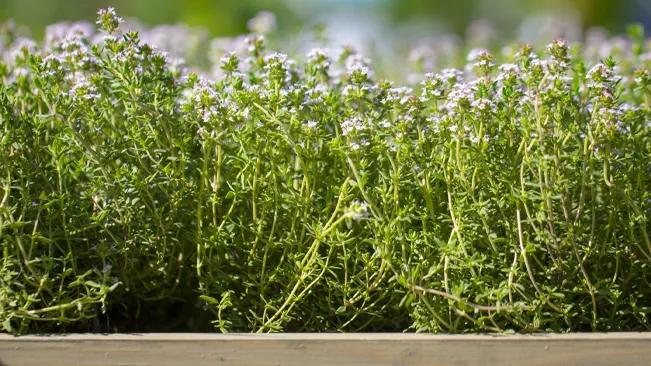
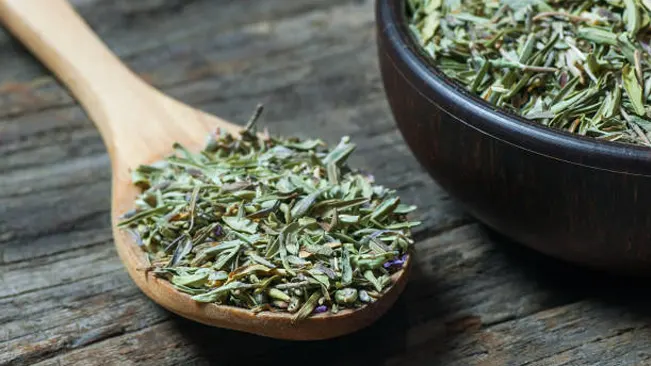
In the kitchen, thyme’s leaves, both fresh and dried, are a staple in various cuisines, imparting a distinctive taste to meats, soups, and stews. This herb is a key component of the classic herb blend Herbes de Provence and is integral in bouquet garni. Beyond its culinary uses, thyme is lauded for its essential oils, which are believed to have antiseptic and antibacterial properties, making it a common ingredient in natural remedies and aromatherapy.
Characteristics of Thyme Plant
| Characteristics | Description |
| Scientific Name | Thymus vulgaris |
| Common Names | Thyme, common thyme, garden thyme |
| Family | Lamiaceae Family |
| Native Region | Mediterranean region |
| Plant Type | Herbaceous perennial |
| Size | Typically 6 to 12 inches tall |
| Leaves | Small, oval, grey-green, aromatic when crushed |
| Flowers | Tiny, tubular, lilac or pale purple, in whorls |
| Propagation | Through seed, cuttings, or dividing rooted sections of the plant |
| Drought Tolerance | High drought tolerance once established |
| Cultural Uses | Widely used for culinary purposes, medicinal applications, and ornamental gardening |
| Ecological Role | Attracts pollinators like bees and butterflies, and acts as a ground cover to help prevent soil erosion |
| Notable Species | Includes Thymus citriodorus (lemon thyme) and Thymus serpyllum (wild thyme) |
| Hardiness Zones | Suited for USDA zones 5 through 9 |
| Growth Rate | Moderate, establishing quickly but spreading slowly |
| Lifespan | Can live several years in the right growing conditions |
Botanical Beauty of Thyme Plant
Thyme plant, Thymus vulgaris, boasts delicate, small leaves that cascade from slender stems, presenting a fine-textured appearance that complements any botanical collection. When in bloom, its pale purple flowers offer a subtle yet enchanting display, attracting the eye of any plant enthusiast. This herb’s petite structure allows it to fit seamlessly into various garden designs, enhancing the overall aesthetic with its understated elegance.
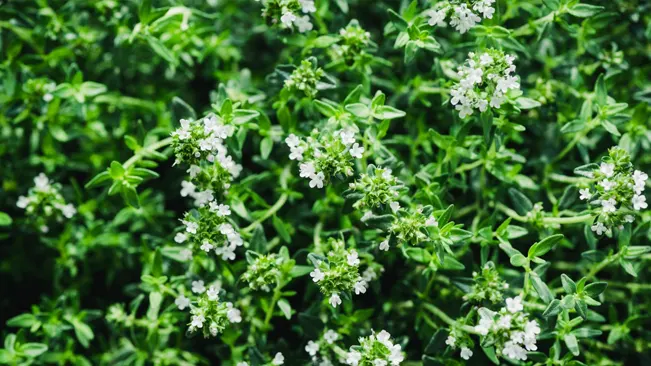

Woodland Elegance
Nestled within a woodland garden, thyme exudes a natural charm, its gray-green foliage blending harmoniously with the dappled light of the understory. Its ability to flower even in the subdued light of a forest setting adds a splash of color to the rich greens typically found in such an environment.
Ecological Importance
Thyme serves as a valuable plant in ecological gardening, attracting a range of pollinators with its nectar-rich flowers. Its dense growth habit also provides shelter for small ground-dwelling creatures, contributing to the biodiversity of the garden ecosystem.
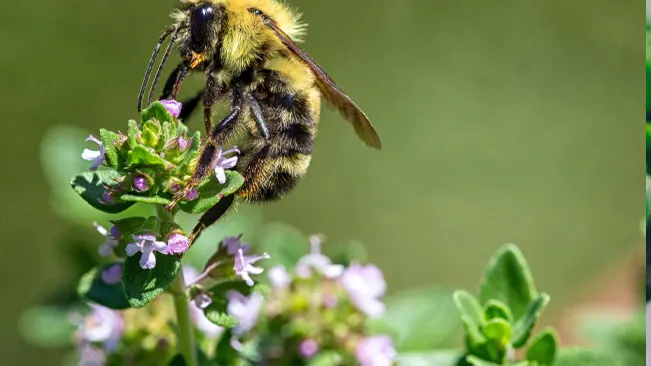
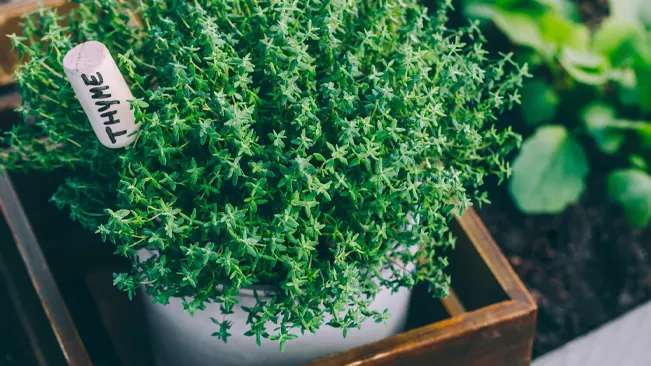
Cultivation and Conservation
Easy to cultivate, thyme is a resilient plant that adapts well to various conditions, making it a stalwart of conservation gardens. By requiring minimal water once established, it supports sustainable gardening practices, helping to conserve resources while providing enduring beauty.
Fragrance
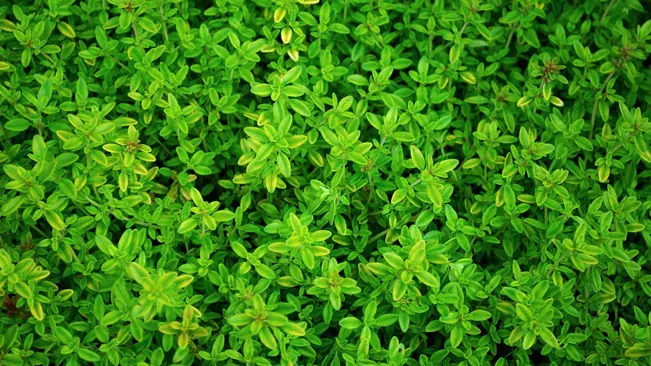
Thyme emits a distinctive fragrance that has filled gardens and kitchens with its earthy, slightly minty aroma for centuries. This aromatic quality is most potent just before the tiny flowers bloom, when the oils within the leaves are at their peak. The scent of thyme is not merely a sensory pleasure but has also been traditionally used to ward off pests and for its antiseptic properties in homes.
The fragrance of Thymus vulgaris is released when its leaves are lightly brushed or when the essential oils are extracted through a distillation process. The herb’s scent profile varies slightly among subspecies, with some exuding notes of lemon or caraway that can be quite pronounced. In the garden, the aroma of thyme can become the backdrop to an olfactory symphony when paired with other herbs and flowers.
Even after harvesting, thyme retains much of its delightful fragrance, making it a favorite for potpourris and sachets. Dried thyme maintains a milder version of its scent, which can persist for months, lending a subtle, lasting fragrance to dried arrangements. Its aroma is also a call to culinary action, hinting at the savory depth it adds to dishes.
Soil Stabilization
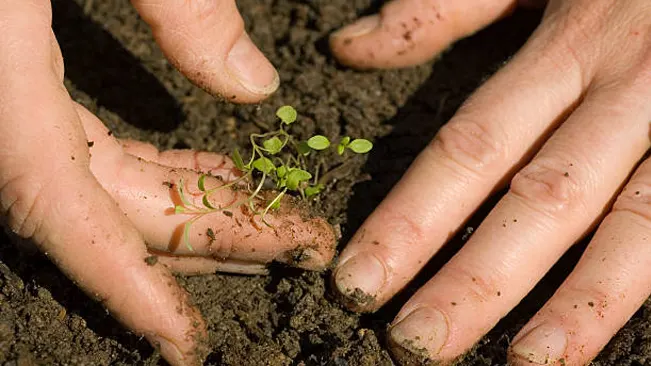
Thyme plants, with their extensive root systems, contribute to soil stabilization, anchoring the soil and preventing erosion. Their hardiness and low maintenance make them suitable for planting in problem areas where other plants might struggle. The mat-forming habit of thyme creates a living mulch that covers the ground, protecting the soil from the direct impact of heavy rains.
In sloped gardens, the cultivation of thyme can be particularly effective in holding soil in place. The roots spread laterally, weaving a tight network that secures the topsoil, which is essential in preventing runoff. When used as a ground cover, thyme contributes to the stability of the garden ecosystem, promoting the health and integrity of the soil.
Over time, the organic matter from decaying thyme leaves enriches the soil, further enhancing its structure and stability. This process encourages the presence of beneficial microorganisms that are essential to the soil food web. Thyme’s adaptability to poor soils also makes it a valuable ally in reestablishing vegetation in degraded lands.
Common Uses
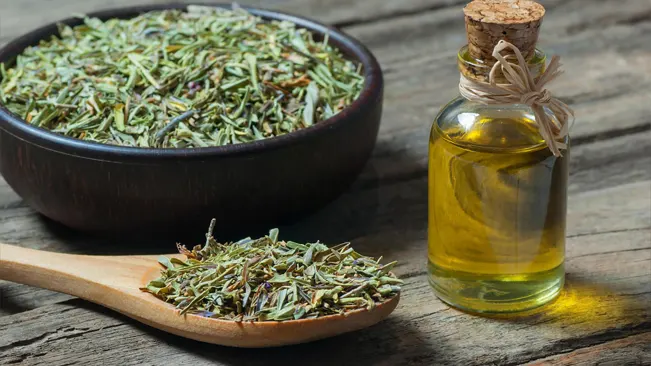
Thyme is a culinary treasure, gracing everything from European to Middle Eastern dishes with its piquant flavor. It is one of the core herbs in the classic French bouquet garni and Herbes de Provence, and is just as comfortable as a seasoning in marinades, stews, and bread. The versatility of thyme extends to the beverage world, where it infuses teas and cocktails with its distinct notes.
Beyond the kitchen, thyme is a fixture in traditional medicine, reputed for its therapeutic properties. Its essential oil, thymol, is an active ingredient in various cough syrups and mouthwashes due to its antiseptic nature. The herb is also used in aromatherapy and natural cleaning products, capitalizing on its refreshing scent and purported antimicrobial qualities.
In ornamental gardens, thyme is prized for its ability to thrive in rockeries, borders, and as a fragrant, flowering ground cover. Its small, attractive blooms are beloved by bees and butterflies, adding life and movement to the garden. Thyme’s resilience to foot traffic also makes it an excellent choice for planting between pavers, where it releases its fragrance when stepped upon.
Benefits
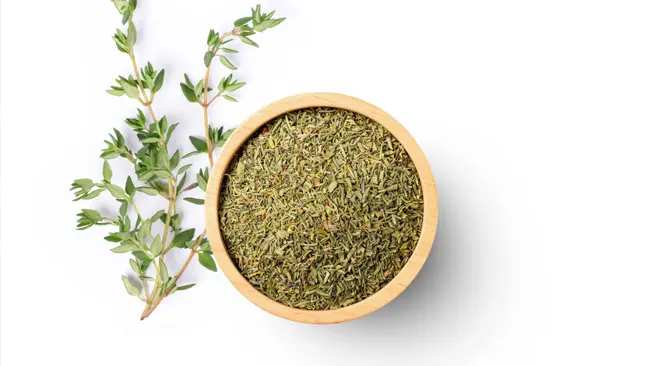
Thyme is celebrated for its range of health benefits, with studies suggesting anti-inflammatory and antibacterial properties. The flavonoids in thyme contribute to its antioxidant activity, supporting the body’s defense against oxidative stress. Furthermore, the regular inclusion of thyme in the diet is thought to contribute to overall wellness, aiding in digestion and possibly improving respiratory function.
The benefits of thyme extend to the garden itself; it’s a drought-tolerant plant that can reduce the need for frequent watering once established. As a companion plant, it can deter pests from more vulnerable plants nearby with its potent scent. Thyme’s presence in a garden contributes to a healthy, natural balance, reducing the need for chemical pesticides and fertilizers.
Cultivating thyme can have a restorative effect on the land. It’s often included in permaculture and regenerative farming practices as it can improve soil quality and promote biodiversity. As part of a polyculture, thyme works symbiotically with other plants, creating a resilient and sustainable growing environment.
Different Species
Thymus citriodorus
(Lemon Thyme)
Offers a refreshing lemon scent, with green foliage edged in golden yellow, making it a culinary favorite for its citrus twist.
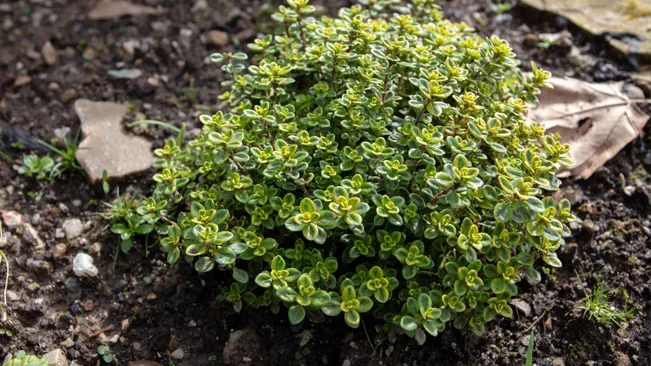
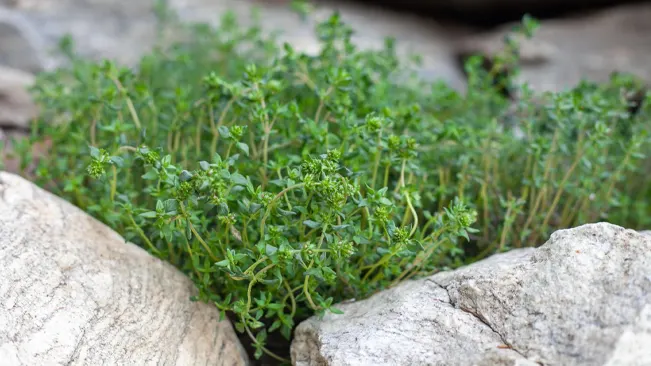
Thymus serpyllum
(Wild Thyme)
A low-growing species that spreads across the ground, producing pink to purple flowers that attract bees and exude a soft, minty aroma.
Thymus herba-barona
(Caraway Thyme)
Characterized by its caraway-scented leaves, this species bears pink flowers and is often used to flavor meats and soups.
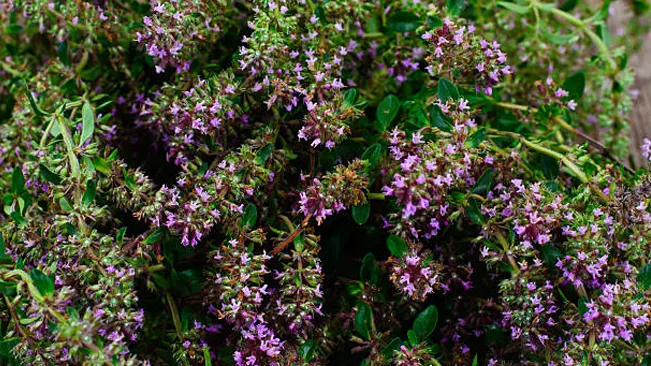
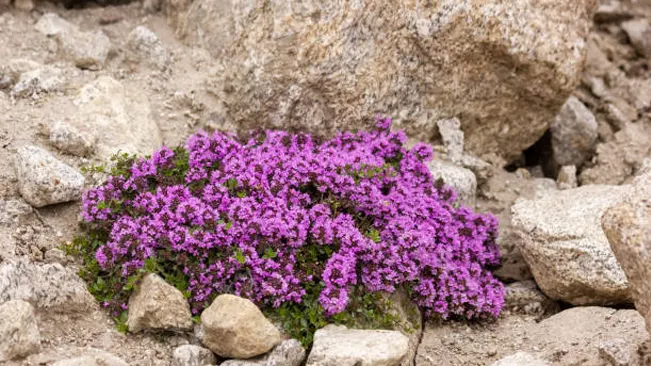
Thymus praecox
(Creeping Thyme)
Known for its dense growth habit, it creates a fragrant ground cover with small, lavender-colored flowers, suitable for rock gardens and between pavers.
Frequently Asked Questions (FAQs)
- What is thyme plant used for?
- Thyme plant is widely used as a culinary herb in dishes like stews, soups, and meats, and for its medicinal properties.
- Thyme plant is widely used as a culinary herb in dishes like stews, soups, and meats, and for its medicinal properties.
- How do you grow thyme plant?
- Grow thyme plant in well-drained soil, full sun, and water it regularly until established; it prefers slightly dry conditions.
- Grow thyme plant in well-drained soil, full sun, and water it regularly until established; it prefers slightly dry conditions.
- When should you plant thyme plant?
- Plant thyme in the spring, after the last frost, to ensure it gets plenty of sunlight and warmth.
- Plant thyme in the spring, after the last frost, to ensure it gets plenty of sunlight and warmth.
- Can you grow thyme plant indoors?
- Yes, thyme plant can be grown indoors in pots with adequate sunlight and good drainage.
- Yes, thyme plant can be grown indoors in pots with adequate sunlight and good drainage.
- How long does it take for thyme plant to grow?
- Thyme plant typically reaches maturity in about 6 to 8 weeks after planting.
- Thyme plant typically reaches maturity in about 6 to 8 weeks after planting.
- Does thyme plant come back every year?
- Thyme plant is a perennial herb, so it can come back year after year if conditions are right.
- Thyme plant is a perennial herb, so it can come back year after year if conditions are right.
- How much water does thyme plant need?
- Thyme plant needs moderate watering and prefers the soil to dry out slightly between waterings.
- Thyme plant needs moderate watering and prefers the soil to dry out slightly between waterings.
- What pests and diseases affect thyme plant?
- Thyme plant can be affected by fungal diseases like root rot and pests such as spider mites and aphids.
- Thyme plant can be affected by fungal diseases like root rot and pests such as spider mites and aphids.
- Can thyme plant be dried for storage?
- Yes, thyme plant can be dried by hanging it in a cool, dry place and then stored in an airtight container.
- Yes, thyme plant can be dried by hanging it in a cool, dry place and then stored in an airtight container.
- What are the health benefits of thyme plant?
- Thyme plant is known for its antibacterial and antifungal properties, and it’s rich in vitamins C and A.


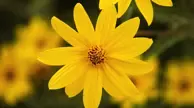

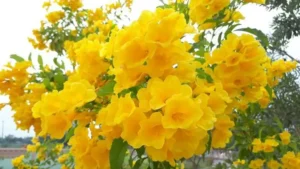


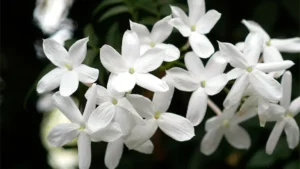
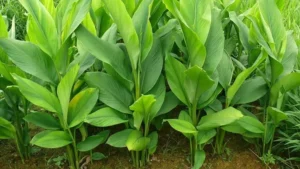
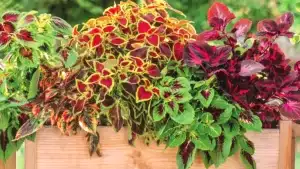
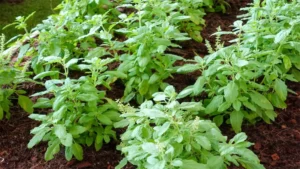

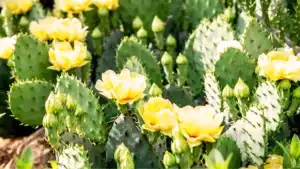

Leave your comment